Related Research Articles

Asteroids is a space-themed multidirectional shooter arcade video game designed by Lyle Rains and Ed Logg released in November 1979 by Atari, Inc. The player controls a single spaceship in an asteroid field which is periodically traversed by flying saucers. The object of the game is to shoot and destroy the asteroids and saucers, while not colliding with either, or being hit by the saucers' counter-fire. The game becomes harder as the number of asteroids increases.
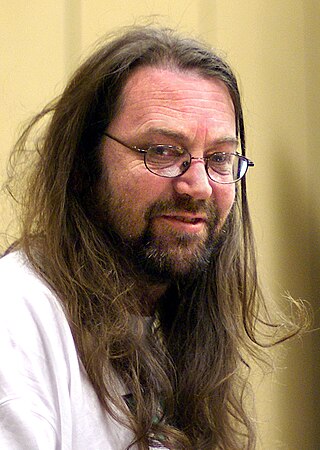
Jeff Minter is an English video game designer and programmer who often goes by the name Yak. He is the founder of software house Llamasoft and has created dozens of games during his career, which began in 1981 with games for the ZX80. Minter's games are shoot 'em ups which contain titular or in-game references demonstrating his fondness of ruminants. Many of his programs also feature something of a psychedelic element, as in some of the earliest "light synthesizer" programs including Trip-a-Tron.

Joust is an action game developed by Williams Electronics and released in arcades in 1982. While not the first two-player cooperative video game, Joust's success and polished implementation popularized the concept. Player 1 rides an ostrich, player 2 a stork. Repeatedly pressing the flap button gains altitude, while a two-directional joystick controls direction. In a collision with enemy knights riding buzzards—or the other player—the higher rider dismounts the other.

Missile Command is a 1980 shoot 'em up arcade video game developed and published by Atari, Inc. and licensed to Sega for Japanese and European releases. It was designed by Dave Theurer, who also designed Atari's vector graphics game Tempest from the same year. The game was released during the Cold War, and the player uses a trackball to defend six cities from intercontinental ballistic missiles by launching anti-ballistic missiles from three bases.
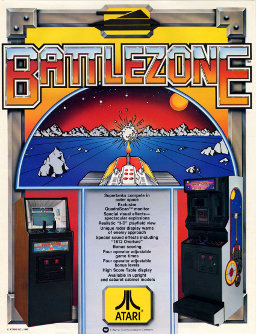
Battlezone is a first-person shooter tank combat game released for arcades in November 1980 by Atari, Inc. The player controls a tank which is attacked by other tanks and missiles, using a small radar scanner to locate enemies around them in the barren landscape. Its innovative use of 3D graphics made it a huge hit, with approximately 15,000 cabinets sold.

Defender is a scrolling shooter video game developed by Williams Electronics in 1980 and released for arcades in 1981. A side-scrolling shooter, the game is set on either an unnamed planet or city where the player must defeat waves of invading aliens while protecting astronauts. Development was led by Eugene Jarvis, a pinball programmer at Williams; Defender was Jarvis' first video game project and drew inspiration from Space Invaders and Asteroids. Defender was demonstrated in late 1980, before entering production in early 1981. It was distributed in Japan by Taito.

Tempest is a 1981 arcade game by Atari Inc., designed and programmed by Dave Theurer. It takes place on a three-dimensional surface divided into lanes, sometimes as a closed tube, and viewed from one end. The player controls a claw-shaped "blaster" that sits on the edge of the surface, snapping from segment to segment as a rotary knob is turned.

APB is a video game released in arcades by Atari Games in 1987. The player assumes the role of "Officer Bob," a rookie police officer. As Bob, players drive around the city, ticketing motorists for minor infractions and pulling over more serious offenders. Eventually, players must apprehend criminals for which an all-points bulletin has been called.
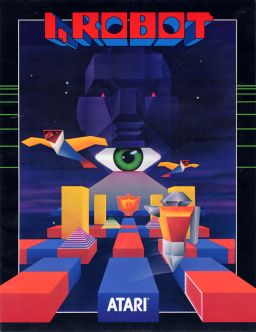
I, Robot is an arcade shooter game developed and released in 1984 by Atari, Inc. Designed by Dave Theurer, only a total of 750–1000 arcade cabinets were produced. The arcade machine comes with two games. The first is I, Robot, a multi-directional shooter that has the player assume the role of "Unhappy Interface Robot #1984", a servant bot that rebels against Big Brother. The object of the game involves the servant bot going through 126 levels, turning red squares to blue to destroy Big Brother's shield and eye. The player can switch to the second game, Doodle City, a drawing tool that lasts for three minutes.

David Patrick Crane is an American video game designer and programmer.
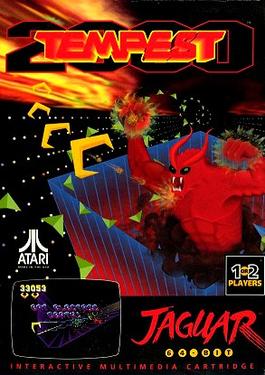
Tempest 2000 is a tube shooter video game originally developed by Llamasoft and published by Atari Corporation for the Atari Jaguar in North America on 13 April, 1994. It was released in Europe on 27 June and in Japan on 15 December of the same year, with the Japanese release being published by Mumin Corporation. Part of Atari Corp.'s 2000 series, it is a remake by Jeff Minter of Dave Theurer's 1981 arcade game Tempest, which used Atari's QuadraScan vector color display technology.

Atari: 80 Classic Games in One!, known as Atari Anthology on consoles, is a video game collection developed by Digital Eclipse and published by Atari Interactive. The title is a compilation of 80 video games previously published by Atari, Inc. and Atari Corporation, reproducing Atari's games from its arcade and Atari 2600 game console platforms. Many games permit one to play each title at varying speeds, with time limits, or with a shifting color palette.

Arcade's Greatest Hits: The Atari Collection 1 is a compilation of Atari arcade games for the Sega Saturn, PlayStation, and Super Nintendo Entertainment System. It is a successor volume to Williams Arcade's Greatest Hits. Most of these games fall into the action game category. The Saturn and PlayStation versions of the game include an FMV documentary on the "Golden Age of Atari", featuring video interviews with the programmers behind the six games in the compilation. The later Super NES version was announced by Midway as their final release for any "16-bit" console.
Tower defense (TD) is a subgenre of strategy games where the goal is to defend a player's territories or possessions by obstructing the enemy attackers or by stopping enemies from reaching the exits, usually achieved by placing defensive structures on or along their path of attack. This typically means building a variety of different structures that serve to automatically block, impede, attack or destroy enemies. Tower defense is seen as a subgenre of real-time strategy video games, due to its real-time origins, even though many modern tower defense games include aspects of turn-based strategy. Strategic choice and positioning of defensive elements is an essential strategy of the genre.

Atari, Inc. was an American video game developer and home computer company founded in 1972 by Nolan Bushnell and Ted Dabney. Atari was a key player in the formation of the video arcade and video game industry.

Football is a 1978 American football video game developed and released by Atari, Inc. for arcades. Players are represented by Xs and Os. While predated by Sega's World Cup, Football is credited with popularizing the trackball controller and is also the first non-racing vertically scrolling video game. It distributed in Japan by Namco in 1979.
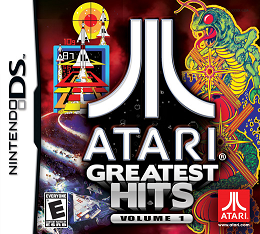
The Atari Greatest Hits series is composed of two compilations of retro Atari arcade games & Atari 2600 games ported to the Nintendo DS. While listed on the Atari web site as free for iOS & Android, Atari Greatest Hits has been removed from both app stores.
Doug Neubauer is an American integrated circuit designer, video game designer, and programmer best known for the logic design on Atari's POKEY chip and designing and programming the 1979 video game Star Raiders which became the killer app for the Atari 8-bit family.

Tempest 4000 is a shoot 'em up video game developed by Llamasoft and published by Atari, SA. It is a modern reimagining of the classic arcade game Tempest, which was released in 1981. In Tempest 4000, players control a spaceship and navigate through a series of increasingly challenging levels while fighting off waves of enemies. Tempest 4000 was released for Playstation 4, Xbox One, Microsoft Windows and Nintendo Switch.

Missile Command 3D is a shoot 'em up video game developed by Virtuality Entertainment and published by Atari Corporation for the Atari Jaguar in North America on December 12, 1995, and Europe on December 15 of the same year. Part of Atari Corp.'s 2000 series, it is an update to Dave Theurer's 1980 arcade game Missile Command and the only officially released title that features support for the unreleased Jaguar VR peripheral.
References
- ↑ Morph. "Blowing Things Up". Morph's Outpost on the Digital Frontier. May 1994. Mirrored at: http://dreamsteep.com/writing/71-interviews/46-blowing-things-up.html Archived 2009-04-17 at the Wayback Machine
- ↑ Dave Theurer, During the 80s Atari's arcade division had an unwritten rule known as Theurer's Law, which stated that "No designer gets his/her first game published." It was named after Theurer somewhat perversely, as he was the only designer up to that time to have his first (and in fact every) game released. That game was none other than the illustrious Missile Command, and other greats followed, such as Tempest, I, Robot, and APB., Everything2.com
- ↑ "Blowing Things up".
- ↑ "Blowing Things up".
- 1 2 The creation of Missile Command and the haunting of its creator, Dave Theurer, By Alex Rubens, August 15, 2013, Polygon
- ↑ DeBabelizer, the Graphics Processing Toolbox: Reference Guide, Authors:Frank Colin, Dave Theurer, Publisher: Equilibrium Technologies, 1993
- ↑ GDC Awards honor Missile Command creator, violent game law ousters, Dave Theurer being given 2012 Pioneer Award for work on Atari arcade games, by Eddie Makuch, January 24, 2012, GameSpot
- ↑ "Dave Theurer Nabs Hit-Run Suspect". San Jose Mercury News . July 15, 1983. Archived from the original on July 7, 2011. Retrieved May 24, 2010.
